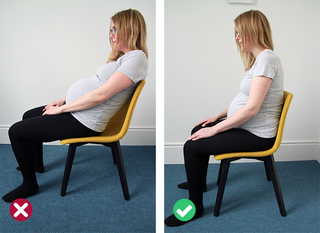You can manage your pelvic girdle pain and prevent it from getting worse by:
- making changes to your daily activities
- doing special exercises
Your physiotherapist will also be able to help. They will tell you about suitable exercises to help your symptoms. They may prescribe abdominal or pelvic support belts, which can provide relief.
They may perform manual therapy to release tight muscles or ease discomfort in pelvic joints. They can give you advice on pain relief methods.
Talk to your GP or obstetrician if the pain remains severe. They can sometimes prescribe medicine to help ease the pain.
Daily activities
You may need to rest more often. Because of this, you should pace your daily activities. You may find it hard to stand for long periods.
Be as active as possible within your pain limits and avoid activities that make the pain worse. Ask for or accept help with your daily tasks.
Posture
Correct posture during pregnancy
Always maintain equal weight through both feet.
For example:
- avoid standing on 1 leg
- sit when you're getting dressed and undressed
Wear comfortable, supportive shoes and avoid high heels.
Avoid turning quickly or twisting as this can strain your pelvis.
Sitting
Slouching or sitting very straight can put strain on your back and pelvis. Aim for halfway between these 2 positions.

Put a small support such as a cushion or rolled up towel at your lower back. This can help you to avoid slouching.
Sit well back into the chair and take its full support. Do not perch on the edge as your muscles will tire more quickly.
Computers
If using a computer, bring your chair under the desk or bring the keyboard closer. This means your arms can rest by your side as you type. Adjust the monitor so it is at eye level.
Driving
When driving, adjust your seat so that your body is closer to the wheel. This helps prevent slouching.
To get out of the car, slide your seat back to create more space. Move your feet slowly, one at a time towards the door and then step out one foot at a time. Lean forward to stand up. You can use the handle over your door for support.
Stairs
If you find climbing the stairs difficult or painful, go one step at a time. When going upstairs, try leading with the less painful leg. Going downstairs, try leading with the more painful leg and use the bannister for support.
Heavy objects and small children
Take care when:
- pushing a heavy shopping trolley
- lifting heavy objects
- lifting small children
When lifting, bend your knees and keep your feet side by side. Try to reduce the amount of lifting that you do and avoid stooping over.
Sit down or kneel to comfort small children. Let them climb up to you instead of lifting them.
Let small children climb into car seats themselves if they can.
Sleeping
It might be comfortable to lie on your side with a pillow between your knees.
As your pregnancy progresses, try placing an extra pillow or rolled up towel under your bump. This places less strain on your hips and lower back.
If you find your hips are sore or aching. This may be because your mattress is very firm. To help relieve the pain, double over a single duvet and create a little hollow in it, like a nest for your hips.
Moving in bed
When turning in bed, bend your knees up, pull in your tummy muscles and keep your knees together. Turn, moving your shoulder and hip together in one movement.
To get out of bed, roll onto your side. Drop your legs over the edge of the bed. Use your elbow and hands to push your body into a sitting position.
When you want to get into bed, reverse this action.
Housework
Avoid heavy housework such as hoovering. You may find it easier to sit when doing tasks like ironing or preparing food.
